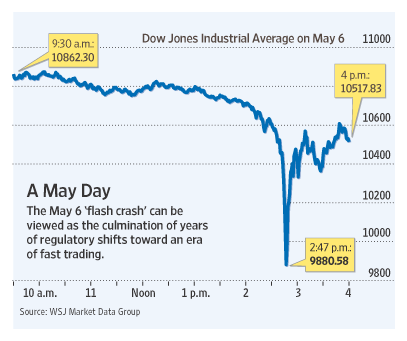“May 6 was clearly a market failure, and it brought to the fore concerns about our equity market structure.”
–Speech by SEC Chairman Mary L. Schapiro
>
What a surprise! The SEC has acknowledged that the flash crash was a structural issue:
As the Securities and Exchange Commission finalizes its report on the May 6 “flash crash,” it is being forced to confront the fallout of its own decisions—which Wall Street sought and cheered—that ushered in an era of fast trading dispersed across dozens of venues.
As recently as this spring, many were applauding the speed, lower costs and competitive nature of the U.S. stock market that largely grew out of a series of policy and technology changes over a decade . . .
What created these structural flaws? A decade of increasing de-regulaton, de-centralization, and privatizing public exchange obligations all worked to release the markets from their historical constraints.
I was somewhat surprised how readily the WSJ acknowledged that the flash crash more or less by Wall Street tinkerings with the basic trading structures. Over the past 13 years, Wall Street requested various regulations, modifications, restructurings — and they were completely accommodated by the SEC, the exchanges, CFTC, CME and others. Whether this was a case of regulatory capture, or a belief in radical deregulation movement is hard to discern at the moment.
Various Wall Street critics quoted in this article blame changes that “left markets more vulnerable to rapid and unchecked swings than had been anticipated.”
Those changes that led to the Flash Crash include the following regulatory changes:
• Regulation ATS: The SEC adopted this reg in 1998 to allow for nonexchanges to execute trades electronically.
• Dark Pools: The rise of private trading venues with no obligations to maintain stability and orderly markets;
• Penny pricing: The 2000 SEC mandate of pricing stocks in pennies instead of 1/8 fractions (reducing per-trade profits and incentives for traders)
• Regulation NMS: In 2005, the SEC adopted opening stock trading to greater competition, thereby ending the duopoly of the New York Stock Exchange and Nasdaq Stock Market. Goodbye specialists, hello dark pools.
• Decentralized Trading Centers: Does having numerous trading centers (vs concentrated exchanges)impact stability? Apparently yes
• Instantaneous bid/offer quotes: There should be minimum requirements on the duration of orders, which can be measured today in 1000s per second.
• Phantom liquidity: High-speed traders do not reliably supply liquidity in a crisis. that disappears when most needed by long-term investors and other market participants?” the release asked.
One area of discussion which I doubt the SEC will discuss is the Exchanges themselves. They are the ones who sold out the investing public, allowing the high frequency, co-located servers, quote sniffing, quote stuffing algo driven traders too steal from the public at will.
In the zero sum game that is trading, every penny in profits of HFTs comes from somewhere: Your pockets. That the NYSE exchanges would even defend this is, quite frankly shameful.
The remaining issue is what the SEC is going to do about this . . .
>
>
Sources:
Strengthening Our Equity Market Structure
Mary L. Schapiro,
U.S. Securities and Exchange Commission
Economic Club of New York, September 7, 2010
http://www.sec.gov/news/speech/2010/spch090710mls.htm
Investors, Regulators Laid Path to ‘Flash Crash’
TOM LAURICELLA, KARA SCANNELL and JENNY STRASBURG
WSJ, September 28, 2010
http://online.wsj.com/article/SB10001424052748704791004575520363764665240.html



What's been said:
Discussions found on the web: